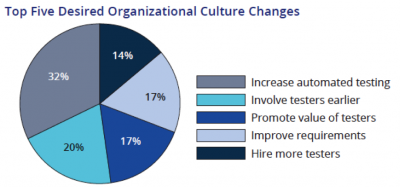The Cultural Changes Testers Most Want to See

TechWell and IBM recently published results from a survey titled “The Future of Testing: Where do Testers Spend Their Time?”
There was a lot of good material in the paper about the state of testing today, but what caught my eye was a chart called Top Five Desired Organizational Culture Changes.

For the past twenty-five years or so, every time I teach a testing class, I start out by asking the audience what their frustrations are related to testing. The two most common answers I hear are late, missing, or inaccurate requirements, and testers not being involved soon enough. The next most common answer is the lack of test automation. Hiring more testers and promoting the value of testers come up occasionally also, especially if it is a management class.
I suppose it is not surprising that the answers I’ve gotten are fairly similar to those obtained from a more scientific poll. The answers I get each week haven’t changed much in the last quarter of a century. I am actually not stunned that many of these issues remain the same, and I really don’t expect them to change any time soon. For example, improving requirements is, in my opinion, largely a human communication issue, so it is not likely to be solved magically with technology or some new process.
I thought it would be interesting to see if other testing-related processes have changed over the years (for better or for worse). I took a look at a Software Practices Survey conducted at a STAR conference in 1992. The results show how testing was handled within projects twenty-two years ago.
Some areas actually seem to be improved. For example, in 1992, more than 43 percent of respondents indicated that their projects lasted longer than a year. I am sure that most projects today are much shorter in duration, and most people would say that is a good thing.
Typical project length | > 43% reported in excess of one year |
Used full time testers | 67% |
Used independent test group | 55% |
Requirements coverage is analyzed | 42% |
Code coverage is analyzed | 27% |
Test effectiveness is measured | 23% |
Testers are formally trained | 29% |
Quality criteria must be met prior to release | 58% |
How do these results compare to your current projects? Why do you think testers are fighting some of the same battles twenty-five years on? What cultural changes would you like to see in your organization?

